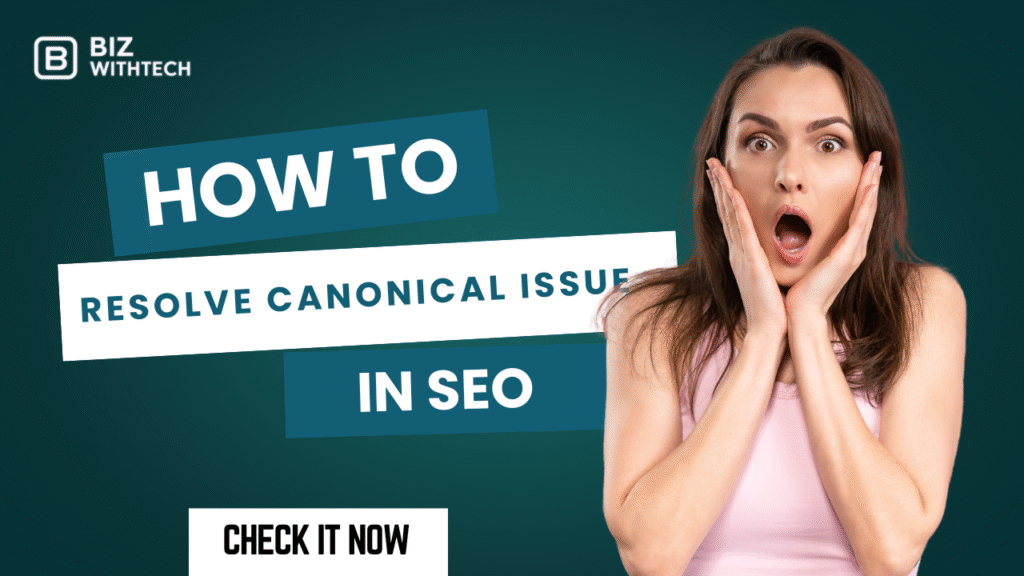Imagine your website pops up in search results. But some links go to http://your-site.com, others to https://www.your-site.com, and a few to https://your-site.com/index.php. All show the same content. This confuses search engines. It waters down your hard work. Canonicalization fixes this. It tells search engines which version of a page is the main one.
Duplicate content can seriously harm your search engine rankings. Search engines might waste time crawling multiple copies of the same page. This means less time for your unique, important content. Your site’s ranking power gets split among these duplicate pages. This guide will show you how to find, diagnose, and fix these problems. We’ll focus on the rel="canonical" tag.
Understanding Canonicalization and Duplicate Content:
What is Canonicalization?
Canonicalization in SEO means picking the main version of a webpage. This happens when many URLs show the same or very similar content. It is like telling search engines, “This is the original page; ignore the others.”
This process is vital for your SEO. It stops search engines from penalizing your site for duplicate content. It also makes sure all the “link equity” or ranking power goes to one strong URL. This boosts that page’s chances to rank higher.
Types of Duplicate Content
Duplicate content appears in many ways. You might not even know it’s happening. These issues can quietly hurt your site.
URL Variations:
Common problems include
httpversushttpsversions of your site. It also coverswwwversus non-wwwURLs. Trailing slashes (/) or missing ones cause issues. Different tracking codes or session IDs in URLs also create duplicates.
Content Duplication:
Sometimes, whole pages get copied by mistake. Printer-friendly versions are one example. Category pages might show product descriptions again. Content shared with other sites without proper linking also causes trouble.
Staging/Development Environments:
You might have a test version of your site. If search engines index this test site, it creates duplicate content. This can happen if the test site isn’t blocked from search engines.
Why Duplicate Content Hurts Your SEO?
Duplicate content is bad for your SEO in several ways. It can make your website perform poorly. You work hard on your site; don’t let this undo your efforts.
Crawl Budget Waste:
Search engines have a “crawl budget.” This is how much time they spend on your site. When bots crawl many copies of the same page, they waste this budget. They might miss new or important unique content.
Diluted Link Equity:
When multiple pages have the same content, backlinks get split. Links pointing to
www.example.com/pageandexample.com/pagedon’t combine their power. This weakens the ranking potential of both pages. No single page gets the full benefit.
Indexing Issues & Penalties:
Search engines might pick the “wrong” page to show in results. Or they might even flag your site for too much duplicate content. This can lead to lower rankings. In some cases, you could face penalties.
Identifying Canonical Issues
Finding canonical issues is the first step. You need the right tools and methods. Knowing where to look helps you quickly fix problems.
1. Using Google Search Console
Google Search Console is a powerful, free tool. It helps you see how Google views your site. You can spot canonical problems here.
Coverage Report:
Go to the “Pages” or “Coverage” report. Look for pages labeled “Excluded.” Check the reasons given. You might see “Duplicate, submitted URL not selected as canonical.” Or you could see “Duplicate, Google chose different canonical than user.” These messages tell you Google sees duplicate content.
URL Inspection Tool:
Use the URL Inspection tool. Type in a URL you suspect has an issue. Look at “Page rendering” and “Indexing allowed?” sections. This shows you what URL Google indexed. It also reveals the canonical tag Google found. This helps you understand if your tag is working.
2. Technical SEO Audit Tools
Beyond Google’s tools, dedicated audit software helps. These tools crawl your site like a search engine. They find many types of errors.
Screaming Frog:
This crawler is very popular. Use Screaming Frog to find duplicate page titles and meta descriptions. It also spots duplicate content body text. You can audit your canonical tag setup across your entire site. This helps you catch missing or incorrect tags.
Other Crawlers:
Tools like SEMrush Site Audit or Ahrefs Site Audit also work well. They offer similar features. These tools help you detect duplicate content. They also find other canonical errors. Use them to get a full picture of your site’s health.
3. Manual Website Review
Sometimes, a quick manual check helps. This lets you confirm issues you found with tools. It also catches things tools might miss.
URL Parameter Check:
Manually check your URLs. Look for common parameter variations. Does
your-site.com?sessionid=123show the same content asyour-site.com? Ensure they all point to one main version.Content Comparison:
Spot-check pages with similar content. Do they appear on different URLs? How are the canonical tags set up on each? This helps you understand content duplication firsthand.
Implementing Canonical Tags Correctly
Adding canonical tags sounds simple. But you need to do it right. Small errors can cause big problems for your SEO. Follow these steps carefully.
1. Self-Referencing Canonical Tags
A self-referencing canonical tag is a best practice. It means a page points to itself as the main version. This tells search engines, “This page is the one.”
- Explanation: A self-referencing tag looks like
<link rel="canonical" href="https://www.example.com/page-url/">. Every indexable page should have one. It confirms the page is the preferred version. This avoids potential confusion, even if no obvious duplicate exists.
- Placement: Always put the canonical tag in the
<head>section of your HTML. Search engines expect to find it there. Placing it elsewhere can cause it to be ignored.
Example: Here is how it should look in your page’s code:
<!DOCTYPE html> <html lang="en"> <head> <meta charset="UTF-8"> < <title>Your Page Title</title> <link rel="canonical" href="https://www.your-site.com/your-page/"> </head> <body> <!-- Page content here --> </body> </html>
2. Canonicalizing URL Variations
You must tell search engines which URL version is primary. This fixes common duplicate content issues. It helps consolidate link equity.
HTTP vs. HTTPS:
Always set the canonical to the HTTPS version. For example, if both
http://your-site.com/pageandhttps://your-site.com/pageexist, the canonical should behttps://your-site.com/page. This makes sure the secure version gets credit.
WWW vs. Non-WWW:
Pick one version and stick with it. If you prefer
www.example.com, thenexample.comshould canonicalize to it. Your canonical tag would point tohttps://www.example.com/your-page/.
Trailing Slashes:
Be consistent with trailing slashes. Decide if your URLs end with a
/or not. Then, ensure all canonicals follow that rule. For instance,https://example.com/page/is the canonical if you use trailing slashes.
URL Parameters:
Tracking or session parameters often create duplicates. You can remove these at the server level. Or, set the canonical tag to the URL without these parameters. So,
https://example.com/product?color=bluewould canonicalize tohttps://example.com/product.
👉 Want to learn step by step how to fix these issues? Watch our video for a detailed guide.
3. Canonicalizing Similar Content
Sometimes, you have different pages with very similar content. A canonical tag helps in these situations too. It directs search engines to the most important version.
Category Pages: If your product listings are on category pages, set the canonical to the main category page. This applies when product details are on separate product pages.
Printer-Friendly Pages: Printer-friendly versions are duplicates. Canonicalize them back to the original, full webpage. This prevents them from being indexed separately.
Syndicated Content: When you republish your content on other sites, use a canonical tag. It should point back to your original source. This confirms your site as the true creator.
Advanced Canonicalization Strategies and Considerations
Beyond basic canonical tags, other methods help. These offer more control in specific situations. Understanding them helps you make smart SEO choices.
1. Canonical Tag vs. 301 Redirects
These two tools are often confused. Both deal with multiple URLs. But they serve very different purposes. Knowing when to use each is key.
Distinction: A canonical tag suggests the preferred version to search engines. It allows multiple URLs to exist and be accessible. A 301 redirect permanently moves users and search engine bots from one URL to another. The old URL effectively ceases to exist for users.
When to Use Each: Use 301 redirects for pages that have moved or been deleted forever. For example, if
old-page.comis nownew-page.com, use a 301. Use canonical tags when you want multiple URLs for one piece of content to exist. This applies to parameter variations or cross-domain syndication.
Combining Strategies: You might use both together. For example, redirect an old URL to a new one. Then, make sure the new URL has a self-referencing canonical tag. This ensures the new page is the primary one.
2. Canonicalization via XML Sitemaps
Your XML sitemap lists all the pages you want search engines to index. It is another way to signal your preferred URLs. This is especially helpful for pages that might not have many internal links.
Purpose: The XML sitemap helps guide search engine crawlers. By listing only canonical URLs, you confirm your choices. This reinforces which pages are the main ones.
Implementation: Only include the canonical URLs in your XML sitemap. Do not list duplicate versions. This tells search engines clearly which pages are important.
3. Canonicalization via HTTP Headers
HTTP headers are usually for non-HTML files. They let you specify a canonical URL for content not in HTML. This can be important for various media types.
Use Case: This method works for files like PDFs or images. If you have several versions of a PDF, you can pick one. This stops search engines from indexing multiple copies.
Format: The syntax looks like this:
Link: <http://www.example.com/main-doc.pdf>; rel="canonical"This header is sent with the file itself.
4. Canonicalization with hreflang
hreflang tags are for international SEO. They tell search engines about different language or region versions of a page. hreflang and canonical tags must work together.
Interaction:
hreflangpoints to specific language versions. Canonical tags point to the preferred version within that language. Make sure your canonical tag on an English page points to the main English page. It should not point to a French page, even if the content is similar.
Best Practices: Every page with
hreflangtags should also have a self-referencing canonical. Ensure the canonical URL listed in thehreflangset is actually the canonical URL for that language version. Consistency prevents confusion.
Troubleshooting Common Canonicalization Mistakes
Even with careful planning, mistakes happen. Knowing common errors helps you fix them fast. It ensures your canonical efforts are not wasted.
1. Incorrect Canonical Tag Implementation
Badly written or placed canonical tags can cause problems. They might not work at all. Or they could point to the wrong page.
Syntax Errors: Watch for missing quotes or wrong attribute values. Make sure
rel="canonical"is exactly correct. Double-check thehrefvalue. A typo in the URL means the tag points nowhere useful.
Canonicalizing to the Wrong URL: This is a big problem. Pointing a canonical tag to a non-existent page makes it useless. Pointing to a broken page or an irrelevant one can confuse search engines. It might even de-index your content.
Canonicalizing a Non-Canonical URL: A page that isn’t the main one should not have a canonical tag pointing elsewhere. If
example.com/page1is the canonical,example.com/page2should point topage1. Butpage1should only point to itself.
2. Over-Canonicalization
Sometimes, you can use canonical tags too much. This means telling search engines to ignore content they should index. It can unintentionally hide valuable pages.
Definition: Over-canonicalization means using canonical tags improperly. For example, you might tag a unique product page to its category page. This tells search engines not to index the product page itself.
Consequences: This can lead to losing unique content from search results. You miss out on ranking for those pages. It hurts your site’s overall visibility and organic traffic.
3. Canonicalization and Indexing Delays
Changes to canonical tags do not always show up instantly. Search engines need time to process them. You need to be patient and keep an eye on your progress.
Patience: Search engines need to re-crawl your pages. This can take days or even weeks. Do not expect instant results after updating canonical tags. They work on their own schedule.
Monitoring: Keep checking Google Search Console. Look at the “Pages” or “Coverage” report. Confirm that your changes are recognized. Make sure Google is choosing the correct canonical URLs.
Conclusion
Canonicalization is a simple but powerful SEO tool. It clears up duplicate content issues. It makes sure your website’s ranking power stays strong. Understanding how to find and fix these issues is crucial for good SEO.
The main ways to solve canonical problems are clear. Use self-referencing canonicals on every important page. Implement your canonical tags correctly, especially for URL variations. Always monitor your site in Google Search Console. It helps confirm your changes are working. Regular SEO audits are smart. Pay close attention to your canonical tags. This keeps your search engine performance at its best.




